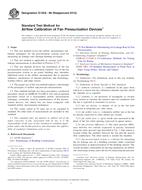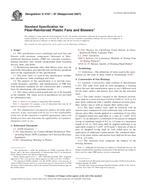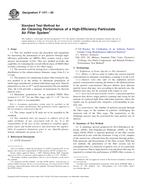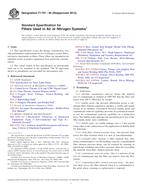Wir benötigen Ihre Einwilligung zur Verwendung der einzelnen Daten, damit Sie unter anderem Informationen zu Ihren Interessen einsehen können. Klicken Sie auf "OK", um Ihre Zustimmung zu erteilen.
ASTM E1258-88(2012)
Standard Test Method for Airflow Calibration of Fan Pressurization Devices
Automatische name übersetzung:
Standardtestverfahren für Luftstromabgleich des Differenzdruckgeräte
NORM herausgegeben am 1.10.2012
Informationen über die Norm:
Bezeichnung normen: ASTM E1258-88(2012)
Anmerkung: UNGÜLTIG
Ausgabedatum normen: 1.10.2012
SKU: NS-41044
Zahl der Seiten: 9
Gewicht ca.: 27 g (0.06 Pfund)
Land: Amerikanische technische Norm
Kategorie: Technische Normen ASTM
Kategorie - ähnliche Normen:
Die Annotation des Normtextes ASTM E1258-88(2012) :
Keywords:
air-leakage measurement, airflow calibration, airflow measurement, building envelopes, fan depressurization devices, ICS Number Code 23.120 (Ventilators. Fans. Air-conditioners)
Ergänzende Informationen
| Significance and Use | ||||||||
|
5.1 The fan pressurization procedure provides a relatively fast evaluation of the airtightness of building envelopes. In order for the accuracy of the test results to be known, the airflow rate measurement technique of the fan pressurization system must be calibrated. 5.2 This test method is applicable to fan pressurization systems that are installed in an opening in the building envelope, as opposed to pressurization techniques involving the mechanical ventilation system of the building. 5.3 The technique of pressurization testing of buildings puts specific requirements on the calibration of fan pressurization systems. The calibration must cover the range of fan pressure differences (approximately 12.5 to 75 Pa) that is induced during pressurization tests. The calibration must also cover a range in fan airflow rates corresponding to the range in building size and airtightness that the fan pressurization system will encounter in the field. 5.4 The fan pressurization system must be calibrated in both directions of airflow used to pressurize and depressurize a building if the system airflow direction is reversible. These two calibrations can be conducted using the various setups described in this test method; however some of the setups can be combined such that a single calibration facility can be used to calibrate the fan in both directions. Such a single setup may involve moving the fan pressurization system from one end of the chamber to the other, reversing the orientation of the system at the same end of the chamber, or it may not require moving the system at all. 5.5 The calibration technique is applicable to the two basic types of fan pressurization systems in use, r/min doors and signal doors. 5.6 For fan pressurization systems that operate in multiple ranges of airflow rate, the system must be calibrated in each range. 5.7 The calibration technique is intended to provide a complete calibration of a fan pressurization system. After calibrating several systems of an identical or similar design, the fan airflow rate may be found to be independent of certain parameters such as fan pressure difference. Other simplifying relations between fan airflow rate and fan speed or fan signal may be observed. If these relations are observed, a manufacturer or other calibrator may choose to simplify the calibration procedure by reducing the number of calibration points. 5.8 The use of fan pressurization systems in actual buildings introduces additional factors that may cause errors in the airflow rate measurement that are not accounted for by the calibration. These factors include operator and weather effects and interference from internal partitions and other obstructions. |
||||||||
| 1. Scope | ||||||||
|
1.1 This test method covers the airflow measurement calibration techniques for fan pressurization systems used for measuring air leakage rates through building envelopes. 1.2 This test method is applicable to systems used for air leakage measurement as described in Practice E779. 1.3 This test method involves the installation of the fan pressurization system in a calibration chamber. Use of the fan pressurization system in an actual building may introduce additional errors in the airflow measurement due to operator influence, interference of internal partitions and furnishings, weather effects, and other factors. 1.4 The proper use of this test method requires a knowledge of the principles of airflow and pressure measurement. 1.5 This standard includes two basic procedures, a preferred procedure, based on ASHRAE 51/AMCA 210, and an optional procedure based on a nonstandard airflow measurement technique, commonly used by manufacturers of fan pressurization devices, but which has not been compared with standard airflow measurement techniques. 1.6 The values stated in SI units are to be regarded as standard. No other units of measurement are included in this standard. 1.7 This standard does not purport to address all of the safety concerns, if any, associated with its use. It is the responsibility of the user of this standard to establish appropriate safety and health practices and determine the applicability of regulatory limitations prior to use. |
||||||||
| 2. Referenced Documents | ||||||||
|
Ähnliche Normen:
Historisch
1.11.2007
Historisch
1.4.2008
Historisch
1.3.2009
Historisch
1.5.2013
Historisch
1.11.2011
Empfehlungen:
EEviZak – alle Gesetze einschließlich ihrer Evidenz in einer Stelle
Bereitstellung von aktuellen Informationen über legislative Vorschriften in der Sammlung der Gesetze bis zum Jahr 1945.
Aktualisierung 2x pro Monat!
Brauchen Sie mehr Informationen? Sehen Sie sich diese Seite an.



 ASTM D4167-97(2007)..
ASTM D4167-97(2007).. ASTM D6830-02(2008)..
ASTM D6830-02(2008).. ASTM F1471-09
ASTM F1471-09 ASTM F1791-00(2013)..
ASTM F1791-00(2013).. ASTM F2105-11
ASTM F2105-11
 Cookies
Cookies
